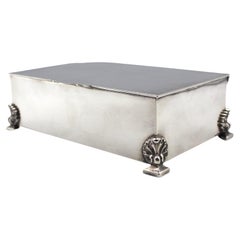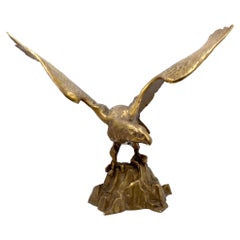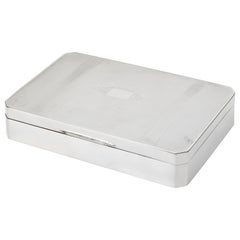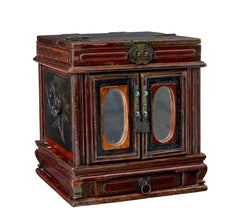The Great Republic Decorative Objects
9
1
to
2
10
10
10
10
2
2
7
1
3
1
2
3
1
1
Height
to
Width
to
9
4
4
1
1
5
5
4
4
2
1
Handcrafted Cigar Humidor Stamped with Elephant, Heart Pine with Rosewood Trim
Located in Colorado Springs, CO
A handsome handcrafted cigar humidor, made from heart pine. This humidor is an exclusive product to The Great Republic, created in a limited edition of only 25. The lid of this distinctive humidor is hand-stamped with an elephant, complete with Rosewood trim.
The elephant appears to be in mid-stride with large tusks...
Category
21st Century and Contemporary American Cigar Boxes and Humidors
Materials
Wood
Silver Plated Keepsake Box, Early 20th Century
Located in Colorado Springs, CO
Offered is a silver plated keepsake box, dating to the early 1900s. The hallmarked box offers great storage solution for jewelry, cufflinks, and other keepsakes, with a divided inter...
Category
Antique Early 1900s English Jewelry Boxes
Materials
Silver
"Come Forth A Dream" Bronze Sculpture by Veryl Goodnight, Ed. 19/25, 1987
Located in Colorado Springs, CO
Presented is an original signed bronze sculpture by American artist Veryl Goodnight. The sculpture is called "Come Forth A Dream" and depicts four running horses, galloping together with free-spirited and unbridled energy. The patinated bronze was cast in 1987 in a very limited edition of only 25. This specific bronze is signed, dated, and numbered 19/25.
Veryl Goodnight(b, 1947) is a celebrated contemporary American artist working in Southwest Colorado. Her studio ranch is situated between Durango and Mesa Verde National Park and the dramatic landscape, abundant wildlife, and fellow ranching community provide endless inspiration for her art. Her many years spent in the West, observing, painting, and sketching her surroundings, gave Goodnight a profound awareness of the mannerisms of ranchers and animals alike. This experience translates directly to her art.
Goodnight has monumental sculptures across the United States, in Europe, and Japan. The most notable is “The Day The Wall Came Down...
Category
Vintage 1980s American Animal Sculptures
Materials
Bronze
Vintage Brass Eagle on Rocks, Circa 1960s
Located in Colorado Springs, CO
Presented is a vintage brass sculpture of a bald eagle on rocks. Made in America in the early 1960s, this sculpture features a large-scale, rea...
Category
Vintage 1960s American Animal Sculptures
Materials
Brass
Hallmarked Silver Plated Keepsake Box, Sheffield, Uk, Circa 1900
Located in Colorado Springs, CO
Offered is a stunning Sheffield silver keepsake box dating to 1900, with associated hallmark. This small box includes a clean interior and rounded corners. The box is free of names or initials, but would have been used to house keepsakes such as jewelry or cufflinks. A well maintained, elegant piece, this antique silver box is an excellent addition to any silver collection.
Trinket or keepsake boxes have taken on many forms since their first conception in ancient times. However their purpose remains the same; to store jewelry and other items precious to the owner. Originally, these boxes were used specifically for jewelry. These were in common use as early as 5000 BC in Ancient Egypt, when the majority of Egyptians, both male and female, wore jewelry. Boxes were used to keep these gemstone encrusted items safe. In Ancient Rome, jewelry was a status symbol. Rings and brooches were utilized to represent ones status in society. Again, boxes were needed for security and storage purposes. Finding early examples of these are quite rare.
Victorian and Edwardian examples of trinket boxes are far more common. This is because owning jewellery was a luxury until the Victorian era- let alone possessing so much a box was needed to store it all. Fine jewelry and other items became available to the masses after the industrial revolution due to the reduction in production costs. This led to a demand for trinket boxes, which were much smaller than jewelry boxes and therefore better suited to the needs of the middle class who did not yet possess an abundance of jewelry.
In Victorian households, collectables and other items of interested were also stashed inside these boxes. This is why they are known as trinket or keepsake boxes, rather than just jewelry boxes, although of course jewelry was also stored in them. Trinket boxes were produced in large numbers around this time. Many were lined with colored plush or velvet or rich wood. More elaborate designs had interior divisions and trays for rings and other pieces of jewellery. It was also common to see trinket boxes so small that they could only contain one item, such as a single ring. Ornate exteriors were created to reflect the value of the trinket boxes contents.
The Edwardian era saw the introduction of new styles of trinket box. These included small circular or oblong boxes...
Category
Antique Early 1900s British Art Deco Decorative Boxes
Materials
Silver
Hallmarked Silver Plated Keepsake Box, Sheffield, UK, circa 1900
Located in Colorado Springs, CO
Offered is a stunning silver plated keepsake box dating to 1900, with associated hallmark. This small box includes a wooden interior with two slots and a blank square on top where initials could have been engraved. A well maintained, elegant piece, this antique silver box is an excellent addition to any silver or home decor collection.
Trinket or keepsake boxes have taken on many forms since their first conception in ancient times. However their purpose remains the same; to store jewelry and other items precious to the owner. Originally, these boxes were used specifically for jewelry. These were in common use as early as 5000 BC in Ancient Egypt, when the majority of Egyptians, both male and female, wore jewelry. Boxes were used to keep these gemstone encrusted items safe. In Ancient Rome, jewelry was a status symbol. Rings and brooches were utilized to represent ones status in society. Again, boxes were needed for security and storage purposes. Finding early examples of these are quite rare.
Victorian and Edwardian examples of trinket boxes are far more common. This is because owning jewellery was a luxury until the Victorian era- let alone possessing so much a box was needed to store it all. Fine jewelry and other items became available to the masses after the industrial revolution due to the reduction in production costs. This led to a demand for trinket boxes, which were much smaller than jewelry boxes and therefore better suited to the needs of the middle class who did not yet possess an abundance of jewelry.
In Victorian households, collectables and other items of interested were also stashed inside these boxes. This is why they are known as trinket or keepsake boxes, rather than just jewelry boxes, although of course jewelry was also stored in them. Trinket boxes were produced in large numbers around this time. Many were lined with colored plush or velvet or rich wood. More elaborate designs had interior divisions and trays for rings and other pieces of jewellery. It was also common to see trinket boxes so small that they could only contain one item, such as a single ring. Ornate exteriors were created to reflect the value of the trinket boxes contents.
The Edwardian era saw the introduction of new styles of trinket box. These included small circular or oblong boxes...
Category
Antique Early 1900s English Art Deco Decorative Boxes
Materials
Silver
Eagle and Flag Bronze Sculpture by Lorenzo E. Ghiglieri, Limited Edition 205/475
Located in Colorado Springs, CO
Presented is a patinated bronze eagle by Lorenzo E. Ghiglieri. The eagle is depicted landing on a tree stump, with wings dramatically raised. The stump is draped with a polychrome American flag. The bronze is signed "Lorenzo Ghiglieri...
Category
Late 20th Century American Animal Sculptures
Materials
Bronze
Patriotic Eagle Bronze Sculpture After Jules Moigniez
By Jules Moigniez
Located in Colorado Springs, CO
Presented is a 20th century bronze sculpture, after Jules Moigniez, of an eagle on a rocky perch. The dignified eagle has its wings tucked and his head turned to the side, showcasing exquisite craftsmanship. Textured feathers, a rugged base, and sharp talons show Moigniez’s artistry at the lost wax process. The bronze sculpture sits atop a marble base.
Jules Moigniez (1835-1894) was a French sculptor widely known for his highly detailed bronze works depicting dynamic wildlife. After studying under Paul Cromolera, Moigniez made a name for himself at his first exhibition in 1855 at the Paris Exposition Universelle. From 1859 to 1892, he showed regularly at the annual Saloons, with a total of 30 recorded works exhibited. A successful sculptor in France, Moignez increased his British and American collector base by exhibiting at the London International Exhibition of 1862.
Intensely dedicated to the process of casting, Jules and his father decided to establish their own foundry in 1857, solely for the purpose of having complete control at every step, as well as the freedom to experiment. They created bronzes with unusually and unique finishes, experimenting in gilded, silver, and multi-color chemical patinas. Most of his works were cast using the lost-wax patina and were always chiseled and chased with great skill and care. While many bronze artists at the time focused solely on the subject, Moigniez incorporated highly detailed bases to accommodate his various animals.
After Jules Moigniez’s tragic death in 1894, his father continued to cast his son’s bronzes from the Moigniez foundry. Just before Moigniez’s father also passed away, he sold the foundry and his casts to Auguste Gouge, a family friend who once cast bronzes for Jules' teacher Paul Cromolera. Gouge continued to produce Moigniez’s bronze sculptures until WWI.
Eagle sculptures, such as this, gained such popularity in America because of the symbolic and historical meanings associated with the elegant bird. The eagle motif has been widely used throughout American history, most notably as part of our Great Seal. The founders of the United States were fond of comparing their new republic with the Roman Republic, in which eagle imagery was prominent. Since then, the eagle motif has appeared in allegorical engravings...
Category
20th Century Sculptures and Carvings
Materials
Bronze
Benjamin Harrison Indian Peace Medal on Presentation Collar, 1889
Located in Colorado Springs, CO
Presented is an original Benjamin Harrison presidential peace medal. This bronze medal was originally struck by the U.S. Mint in 1889 as a peace offering to the various Native American tribes in the U.S. The obverse of the medal has a raised relief side profile bust of President Harrison, with the text "Benjamin Harrison President U.S.A. 1889". The reverse of the medal has the word "PEACE" at top, with a scene of a settler and Native American talking in front of a log cabin. Below, a crossed tomahawk and peace pipe are enclosed by a wreath of laurel leaves. The medal is displayed on a blue velvet presentation collar with gold striped edging and light purple fabric on the reverse. The medal is attached under a blue fabric covered button.
Following the British and French practice of handing out silver medals to tribal chiefs, George Washington began a policy of presenting peace medals to American Indian leaders at treaty signings and other formal ceremonies. Every subsequent American president from Thomas Jefferson to Benjamin Harrison is represented on a presidential peace medal, with the exception of William Henry Harrison...
Category
Antique 1880s American Historical Memorabilia
Materials
Bronze
Silver Sheffield Cricket Sugar Jar, circa 1900
Located in Colorado Springs, CO
This is an exquisite early 20th century crystal jar with a silver lid and spoon. The lid's top is fashioned after a cricket wicket. The jar sits on a round silver base with decorativ...
Category
Antique Early 19th Century British Sheffield and Silverplate
Materials
Silver
Related Items
Early 20th century lacquered vanity box
Located in Debenham, Suffolk
Early 20th century lacquered vanity box circa 1910.
Good quality Chinese export table top vanity box. Hand painted in a plum and black colour scheme in a lacquered finish.
Cube sh...
Category
Antique Early 19th Century Chinese Chinese Export Jewelry Boxes
Materials
Wood, Lacquer
Edwardian Diminutive Post Box, Early 20th Century
Located in Spencertown, NY
The oak box with brass Royal Georgian plaque on top, pick up times on the front. The brass lock and key affixed to the door.
Category
Antique Late 19th Century English Edwardian Decorative Boxes
Materials
Brass
A Memphis Style Sculpture by Luciano Palmieri Italy 1987
By Luciano Palmieri
Located in HYÈRES, FR
A copper sculpture by Luciano Palmieri 1987s
Aerosol painted.
Named : " Vasqua "
Memphis Style
Signed under
Category
Vintage 1980s Italian Abstract Sculptures
Materials
Copper
1984 Erte Ltd Ed "Angel" Bronze Sculpture by Romain De Tirtoff
By Erté
Located in North Bergen, NJ
1984 Erte limited edition "Angel" bronze sculpture by Romain de Tirtoff.
Comes with black pedestal dimensions:
Height 42.5 inches
Width 13 inches
Depth 21 inches.
Category
Vintage 1980s Art Deco Figurative Sculptures
Materials
Bronze
Large Early 20th Century Belgian Oak Folk Art Eagle Sculpture
Located in Haddonfield, NJ
Early 20th century Belgian oak Folk Art eagle sculpture.
Category
Vintage 1920s Belgian Folk Art Animal Sculptures
Materials
Oak
Mid Century Hand Crafted Burlwood Humidor Cigar Storage Box
By Dunhill
Located in Chula Vista, CA
20th Mid Century Hand crafted Burlwood Humidor Cigar Storage Box
In the manner of Dunhill and Davidoff
4.75 h x 11 w x 9.75
Burl wood with exotic woods.
Preowned original vintage con...
Category
Mid-20th Century Mid-Century Modern Cigar Boxes and Humidors
Materials
Wood, Burl
Beautiful Hand Crafted Cigar Humidor Box Catchall Antique Austria, 1910s
Located in Nuernberg, DE
A cigar or desktop catchall box from Austria in the 1900s, made of patinated brass and wood, sounds like a unique and valuable antique.
The fact that this particular box is an antique from the early 1900s adds to its value and collectability. Depending on the condition and other factors such as the brand or maker, it could be worth a significant amount of money to collectors of antique smoking...
Category
Vintage 1910s Austrian Mid-Century Modern Cigar Boxes and Humidors
Materials
Metal
H 2.25 in W 9.5 in D 5.88 in
Early 20th Century Antique Tibetan Silver Turquoise Ghau Prayer Box
Located in Pomona, CA
Ghau is a small prayer box worn as pendant by Buddhists as portable shrines which can be pray by prayer during their travel. This Ghau prayer box (travel Buddha...
Category
Early 20th Century Chinese Chinese Export Decorative Boxes
Materials
Silver
Sergio Bustamante Copper & Brass Parrot on a Swing
By Sergio Bustamante
Located in Stamford, CT
Bustamante brass parrot on a swing. Do not see a signature. In excellent condition.
Bird comes off swing for packing.
Category
Vintage 1970s Mexican Animal Sculptures
Materials
Brass, Copper
Arts & Crafts Mission Oak with Copper Strapping Cigar Humidor Gustav Stickley
By Gustav Stickley
Located in Port Jervis, NY
Fabulous quarter sawn oak with hand Hammered copper straps and handles with a bronze patina in the style of Gustav Stickley. Has a key with working lock. In excellent antique condit...
Category
Antique Early 1900s American Arts and Crafts Cigar Boxes and Humidors
Materials
Bronze
H 8.75 in W 12.5 in D 15.5 in
Early 20th Century Shell Crystal Jewelry Box
Located in Barcelona, Barcelona
Shell crystal jewelry box.
By unknown manufacturer from France, early 20th century.
In original condition, with minor wear consistent with ag...
Category
Early 20th Century French Other Jewelry Boxes
Materials
Glass
Antique Victorian Brass Bound Oak Cigar Humidor 19th Century
Located in London, GB
This is a stylish antique Victorian oak brass and cedar lined tabletop cigar humidor circa 1860 in date.
The rectangular box features a lift out tray and adjustable divisions with sunken handles to the sides and a hinged lid with a central brass shield.
Complete with the original Bramah lock and key.
It would make a beautiful gift to any connoisseur of fine cigars.
Condition:
In excellent condition. As an antique items, the humidor shows signs of use commensurate with age, these minor condition issues are mentioned for accuracy and, as seen in the accompanying photographs, it displays beautifully.
Dimensions in cm:
Height 19.5 x Width 44 x Depth 29
Dimensions in inches:
Height 8 inches x Width 1 foot, 5 inches x Depth 11 inches
Humidor
is any kind of box or room with constant humidity that is used to store cigars, cigarettes, orpipe tobacco. For private use, small wooden or acrylic glass humidor boxes for a few dozen cigars are used, while cigar shops may have walk-in humidors.
Humidors can be used to store other goods for which a certain level of humidity is desirable; the Colorado Rockies Major League Baseball team stores game balls in a large humidor at their home stadium, Coors Field, to counteract the effects of Denver's high altitude and generally low humidity. Humidors of all sizes use hygrometers to keep track of the humidity levels.
Classification of humidors
Walk-in humidor - most common in cigar bars or stores. One room is built as or converted to a humidor where all the cigars are stored.
Cabinet humidor - usually placed on the floor as a piece of furniture. Typically holds 1000-5000 cigars.
Table humidor - often quite heavy, though portable in theory, it's usually kept in one location. Capacity ranges from three hundred to a few thousand cigars. It usually comes with a polished wood exterior, marble, leather or combination of exotic elements, and glass top.
Personal humidor - semi-regular cigar smokers will sometimes keep a small humidor in their homes for personal storage, special events, or aesthetic characteristics of the humidor itself . Usually contains 20-75 cigars. This may also be known as a "Desktop Humidor".
Travel humidor - portable and made for carrying cigars enough for the outing or event, usually 2 to 10 cigars.
Oak
is a tree or shrub in the genus Quercus - Latin "oak tree" having approximately 600 extant species. Oak wood has a density of about 0.75 g/cm3, great strength and hardness, and is very resistant to insect and fungal attack because of its high tannin content. It also has very appealing grain markings, particularly when quartersawn. Oak wood is very durable, easy to maintain and resistant to wear and tear which is why it can be easily handed to the next generations if taken well care of.
Oak wood virtually lasts forever and you can still admire oak furniture in museums and palaces even if it was made many centuries ago. Oak has been prized since the Middle Ages for use in interior panelling of prestigious buildings such as the debating chamber of the House of Commons in London and in the construction of fine furniture.
Bramah
is London's oldest security company. Established at 124 Piccadilly, London in 1784, and today based in Marylebone, London and Romford, Essex.
Bramah made their first lock in 1784 and the patent was awarded in 1787. The designer was Joseph Bramah. Joseph Bramah was a leading inventor of the industrial revolution, patenting over 18 new ideas, including a new valve for the water closet (toilet), the hydraulic pump, a fountain pen, and a fire engine.
Bramah also introduced a beer hand pump for use at the bar, to prevent fluid loss when barmen went downstairs to pour a new jug! Due to the quality of his manufacturing, his name became a by-word amongst British Engineers for engineering excellence and many of his inventions are on display in the Science Museum in London. You can find one of his original toilets still working in Osborne House, Queen Victoria's home on the Isle of Wight.
The Bramah lock was unique and advanced property and valuables protection enormously. Indeed it was 50 years ahead of any Chubb lock...
Category
Antique 1860s English Victorian Cigar Boxes and Humidors
Materials
Oak, Cedar






